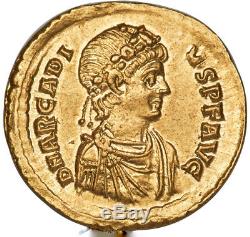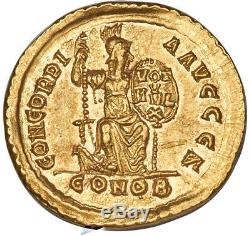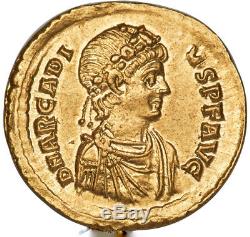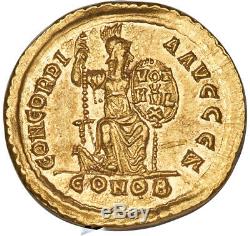Roman Emperor Arcadius AV Solidus gold coin 383-408 AD Choice AU





Does not include items damaged within first 30 days. Weak Ruler, but Father of the Wall-builder Theodosius II. Flavius Arcadius (Greek: , Árkádios; 1 January 377 1 May 408) was Eastern Roman emperor from 395 to 408.
He was the eldest son of Theodosius I and his first wife Aelia Flaccilla, and brother of the Western emperor Honorius. A weak ruler, his reign was dominated by a series of powerful ministers and by his wife, Aelia Eudoxia. [2] In noting the character of Arcadius, the historian J. Bury described him and his abilities thus: He was of short stature, of dark complexion, thin and inactive, and the dullness of his wit was betrayed by his speech and by his sleepy, drooping eyes.
His mental deficiency and the weakness of his character made it inevitable that he should be governed by the strong personalities of his court. [54] Traditional interpretations of the reign of Arcadius have revolved around his weakness as an Emperor, and the formulation of policy by prominent individuals (and the court parties that formed and regrouped round them) towards curtailing the increasing influence of barbarians in the military, which in Constantinople at this period meant the Goths.
Scholars such as the historian J. Bury spoke of a group in Arcadius's court with Germanic interests and, opposed to them, a Roman faction. [55] So when interpreting the revolt of Gainas and the massacre of the Goths in Constantinople in 400, the episode has been traditionally interpreted by scholars such as Otto Seeck as a violent anti-barbarian reaction that functioned to stabilize the East and prevent the rise of all powerful Romanised barbarian military leaders such as Stilicho in the West - what has been termed the victory of anti-Germanism in the eastern empire. [56][57] The main source of this interpretation has been the works Synesius of Cyrene, specifically Aegyptus sive de providentia and De regno. Both works have traditionally been interpreted to support the thesis that there were anti-barbarian and pro-barbarian groups, with the Praetorian Prefect Aurelianus being the leader of the anti-barbarian faction.
[58] Recent scholarly research has revised this interpretation, and has instead favoured the interaction of personal ambition and enmities among the principal participants as being the leading cause for the court intrigue throughout Arcadius's reign. [59] The gradual decline of the use of Gothic mercenaries in the eastern empire's armies that began in the reign of Arcadius was driven by recruitment issues, as the regions beyond the Danube were made inaccessible by the Huns, forcing the empire to seek recruitment in Asia Minor. [60] The current consensus can be summarised by the historian Thomas S.
Burns: Despite much civilian distrust and outright hatred of the army and the barbarians in it, there were no anti-barbarian or pro-barbarian parties at the court. [61] With respect to Arcadius himself, as emperor was more concerned with appearing to be a pious Christian than he was with political or military matters. Not being a military leader, he began to promote a new type of imperial victory through images, not via the traditional military achievements, but focusing on his piety. [62] Arcadius's reign saw the growing push towards the outright abolishment of paganism. [63] On 13 July 399, Arcadius issued an edict ordering that all remaining non-Christian temples should be immediately demolished. In terms of buildings and monuments, a new forum was built in the name of Arcadius, on the seventh hill of Constantinople, the Xrolophos, in which a column was begun to commemorate his'victory' over Gainas (although the column was only completed after Arcadius' death by Theodosius II). The Pentelic marble portrait head of Arcadius (now in the Istanbul Archaeology Museum) was discovered in Istanbul close to the Forum Tauri, in June 1949, in excavating foundations for new buildings of the University at Beyazit.[64] The neck was designed to be inserted in a torso, but no statue, base or inscription was found. The diadem is a fillet with rows of pearls along its edges and a rectangular stone set about with pearls over the young Emperor's forehead. A more nuanced assessment of Arcadius's reign was provided by Warren Treadgold: By failing to reign, Arcadius had allowed a good deal of maladministration. But by continuing to reign - so harmlessly that nobody had taken the trouble to depose him - he had maintained legal continuity during a troubled time.
[65] Arcadius had four children with Eudoxia: three daughters, Pulcheria, Arcadia and Marina, and one son, Theodosius, the future Emperor Theodosius II. The item "Roman Emperor Arcadius AV Solidus gold coin 383-408 AD Choice AU" is in sale since Monday, August 10, 2020.
This item is in the category "Coins & Paper Money\Coins\ Ancient\Roman\ Imperial (27 BC-476 AD)". The seller is "redoubt_numismatics" and is located in San Antonio, Texas.This item can be shipped worldwide.
- Cleaned/Uncleaned: Uncleaned
- Country/Region of Manufacture: Italy
- Certification Number: 5745609-011
- Certification: Uncertified
- Date: 383-408 AD
- Grade: Choice AU
- Year: 383-408 AD
- Composition: Gold
- Ruler: Arcadius
- Historical Period: Roman: Imperial (27 BC-476 AD)
- Provenance: Ownership History Not Available
- Denomination: Solidus
- KM Number: RIC IX# 46f
- Era: Ancient
- Diameter: 21mm
- Weight: 4.45 grams
- Die Alignment: 6h

